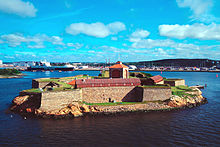Nya Elfsborg
The Nya Elfsborg ( Swedish for new Älvsburg ) is a fortress in the mouth of the Göta älv river in the Kattegat . It is located on the northern edge of the harbor entrance to Gothenburg on the small island of Kyrkogårdsholmen, where it was built in 1650 as a replacement for the disused Älvsborg fortress .
history
Emergence
As early as 1645, a temporary gun emplacement was built on Kyrkogårdsholmen to defend Gothenburg. Two years later work began to permanently fortify the position according to plans by Quartermaster General Johan Wärnschiöldh . After the plans were changed in 1651, the fortress was finally realized as a pentagonal bastion with a hornwork behind . When Denmark entered the Second Northern War in 1657 , the as yet unfinished fortress had to be temporarily placed in a state of defense.
The fortification work continued after the end of the war; However, the fortress was not completed until the end of the 1670s. When the old fortress Älvsborg was razed in 1661, the complex was named Nya Elfsborg . In 1686 a tower was added. In the 1690s the fortress fell into disrepair until the work on the hornwork, which had since been broken off, was resumed in 1697.
Danish raids
On May 2, 1717, the Danish-Norwegian leader of the Kattegatt squadron , Peter Tordenskiold , managed to pass the Nya Elfsborg unnoticed and attack the Gothenburg fleet. The attack failed, however, and while retreating Tordenskiold was bombed from Nya Elfsborg.
On July 20, 1719 Tordenskiold returned and in the evening was able to place 36 sixteen pounder cannons on the island of Stora Aspholmen , located directly in the north-west of Nya Elfsborg . In addition, he brought four heavy mortars to the neighboring Lilla Aspholmen . That same evening he opened fire; the following day, eleven Danish ships also shot at the Nya Elfsborg. Although the fortress was under-staffed and stocked, the commander Johan Lillie refused to surrender. On the night of July 24th, Georg Bogislaus Staël von Holstein brought four cannons and a 40-pound mortar from Gothenburg to Arendal on the north beach of the Älvsborgsfjord and set up a position there so that fire on Tordenskiold could be opened the next morning. Thereupon the latter withdrew and gave up his mortar on Lilla Aspholmen .
Tordenskiold blocked the access to Nya Elfsborg until September 22nd, but the serious damage was immediately repaired. After this incident, the Nya Elfsborg was so carefully maintained that in 1744, when a Danish threat of war was averted, it was the best-kept fortress in the entire empire.
Peacetime
Between 1762 and 1766 the Nya Elfsborg was equipped with bomb-proof storage vaults and stone crew quarters. Finally it was repaired again in 1808 and then well looked after until it was decommissioned in its function as a fortress in 1869.
In 1878 a fortification commission wanted to rebuild the Nya Elfsborg using steel structures, and later it was even suggested that the Nya Elfsborg could become part of the protection for the harbor entrance. However, these considerations did not lead to any further than the temporary establishment of a supply shipyard for coastal artillery in Nya Elfsborg.
Today, the Nya Elfsborg, which has been a listed building as Byggnadsminne since 1935 , is a tourist attraction that can be reached on regular boat tours from Gothenburg in summer. Theatrical performances are often held in the fortress.
Web links
- Entry in the bebyggelseregistret des Riksantikvarieämbetet (Swedish)
Coordinates: 57 ° 41 ′ 6 ″ N , 11 ° 50 ′ 20 ″ E
